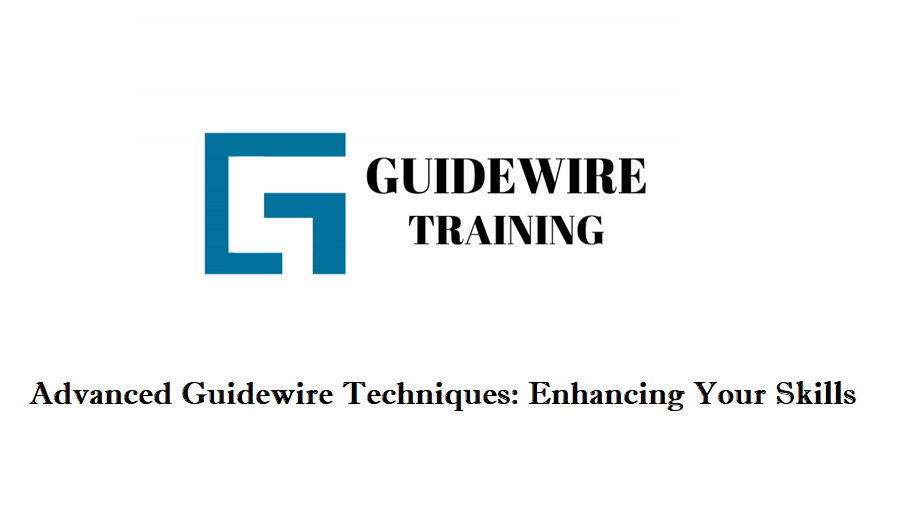Advanced Guidewire Techniques: Enhancing Your Skills

Introduction to Guidewire: Overview and benefits
Guidewire is a leading software platform used by insurance companies to manage their core operations. It provides a comprehensive suite of applications designed to support policy administration, claims management, and billing processes. Guidewire’s platform enables insurers to streamline their operations, improve efficiency, and deliver better customer experiences.
One of the main benefits of using Guidewire is its ability to centralize data and automate manual processes. By consolidating information from various sources into a single system, insurers can eliminate data duplication and ensure consistency across different departments. This not only reduces the risk of errors but also improves productivity by eliminating time-consuming tasks such as manual data entry.
Moreover, Guidewire offers advanced analytics capabilities that enable insurers to gain valuable insights from their data. By analyzing patterns and trends in customer behavior, claims processing times, or underwriting risks, insurance companies can make informed decisions and develop strategies to optimize their business operations. The platform also provides real-time reporting tools that allow managers to monitor key performance indicators (KPIs) and track the progress towards business goals.
In conclusion, Guidewire is a powerful software platform that helps insurance companies transform their operations by centralizing data, automating processes, and enabling advanced analytics. By leveraging these capabilities, insurers can enhance their operational efficiency while delivering superior customer service. Whether it’s streamlining policy administration or improving claims management, adopting Guidewire can be an essential step towards modernizing insurance operations in today’s digital age.
Understanding the Guidewire suite: Policy Center, Billing Center, and Claims Center
—————————————-
In the context of advanced Guidewire techniques, it is crucial to have a clear understanding of the Guidewire suite, specifically Policy Center, Billing Center, and Claims Center. Policy Center serves as a comprehensive platform for managing insurance policies throughout their lifecycle. This includes functionalities such as quoting and underwriting policies, implementing rating plans, managing renewals and endorsements, and handling policy transactions.
On the other hand, Billing Center focuses on streamlining the billing process for insurance companies. It enables insurers to create and manage billing accounts, generate invoices and statements, accept payments through various channels, set up payment plans and installment options, handle delinquencies or late fees effectively.
Lastly, Claims Center plays a vital role in automating claims management processes. It facilitates end-to-end claim handling from reporting incidents to investigating claims’ validity to evaluating damages or losses and finally processing settlements or payouts efficiently. With its robust features like integrated case management tools and configurable workflows supporting different claim types (automobile accidents, property damage), Claims Center enhances operational efficiency while ensuring compliance with regulatory requirements.
Understanding these three components of the Guidewire suite will enable insurance professionals to leverage them effectively in enhancing their skills in areas like policy administration accuracy, billing system efficiency improvement efforts or streamlining claims management processes with automation techniques.
Guidewire architecture and system components
—————————————-
Guidewire architecture is the foundational structure that enables the smooth functioning of the Guidewire system. It consists of various system components that work together to support insurance processes and operations. One key component is the PolicyCenter, which handles policy administration tasks such as underwriting and quoting. Another important component is ClaimCenter, which manages claims processing workflows and facilitates efficient claims handling.
Additionally, BillingCenter is responsible for premium billing and invoicing activities within the Guidewire system. These components are interconnected through a robust integration layer called Guidewire Studio, which allows seamless communication between different modules and facilitates data exchange across systems.
Furthermore, Guidewire architecture also includes a database management system that stores all relevant data related to policies, claims, billing, etc., ensuring data integrity and accessibility. Overall, this well-designed architecture and its various system components play a crucial role in streamlining insurance operations, enhancing efficiency, and providing a seamless user experience to insurers using the Guidewire platform.
Guidewire user interface and navigation
—————————————-
The Guidewire user interface and navigation are crucial aspects of mastering the platform and enhancing your skills. With a well-designed user interface, users can easily navigate through different sections of the software, making it more efficient and seamless to perform various tasks. The layout and organization of the interface should be intuitive to allow users to quickly find what they need without unnecessary clicks or searches.
In addition to a user-friendly interface, effective navigation is essential for maximizing productivity in Guidewire. Users should be able to move between different screens, modules, or functionalities effortlessly. This includes having clear menus, breadcrumbs, or shortcuts that enable users to access specific areas within the software directly. Additionally, providing search functionalities can help users locate specific options or features quickly.
By focusing on improving the user interface and navigation in Guidewire, you can streamline workflows and ensure optimal utilization of the platform’s capabilities. It allows users to interact with the system efficiently and enhances their overall experience while working with Guidewire insurance solutions.
Policy administration basics: creating and managing policies
—————————————-
In the realm of insurance, policy administration is a critical aspect of ensuring operational efficiency and compliance. It involves the creation, implementation, and management of policies that govern how an insurance company conducts its business. Creating policies starts with identifying the need for a new or revised policy, conducting thorough research and analysis to gather necessary information, and defining clear objectives and desired outcomes. Once the policy is drafted, it needs to go through a review process involving key stakeholders and subject matter experts to ensure accuracy, relevance, and alignment with regulatory requirements.
Managing policies requires careful attention to detail and effective communication across various departments within the organization. Policies must be regularly monitored and updated as needed to reflect changes in laws, regulations, or industry standards. An effective policy management system should include mechanisms for tracking policy changes, communicating updates to employees or agents affected by the policy changes, enforcing compliance with policies through training programs or audits, and resolving any disputes or issues related to policy interpretation or implementation.
By mastering these basics of creating and managing policies in insurance policy administration systems like Guidewire PolicyCenter®, insurers can streamline their operations while maintaining compliance with regulatory requirements. This allows them to adapt quickly to market trends, provide better customer service by addressing customer needs promptly and accurately, reduce risks associated with non-compliance or improper implementations of policies, enhance productivity by automating manual processes involved in policy administration tasks such as underwriting or claims processing. Overall it helps insurers build a strong foundation for growth while staying competitive in today’s dynamic insurance landscape.Take Your Career next level with our Tibco BE Training
Billing and invoicing processes in Guidewire
—————————————-
Billing and invoicing processes in Guidewire are essential for insurance companies to effectively manage their financial transactions. These processes involve generating invoices, tracking payments, managing billing cycles, and ensuring accurate and timely billing for policyholders. Guidewire provides a comprehensive platform that enables insurers to streamline these processes, reduce errors, and improve efficiency.
The billing module in Guidewire allows insurers to configure various payment options and plans based on policyholder preferences or regulatory requirements. It enables the generation of bills automatically or on a scheduled basis, reducing manual effort. Additionally, Guidewire’s invoicing functionality supports the customization of invoice templates with company branding and specific information relevant to each policyholder.
Furthermore, Guidewire’s billing and invoicing processes integrate seamlessly with other modules such as claims management and underwriting. This integration ensures consistency in data across different systems and enhances the overall customer experience by providing a single view of all financial transactions related to an insurance policy. Overall, leveraging advanced techniques in Guidewire for billing and invoicing can significantly improve operational efficiency for insurance companies while providing a seamless experience for policyholders.
Guidewire project management techniques and methodologies
—————————————-
One of the key techniques used in Guidewire project management is Agile methodology. This approach focuses on iterative and incremental development, allowing for flexibility and the ability to adapt to changing requirements. With Agile, teams work in short sprints, completing small chunks of work within a set timeframe. This allows for regular feedback and collaboration with stakeholders throughout the project.
Another important technique in Guidewire project management is the use of Kanban boards. Kanban is a visual workflow management system that helps teams visualize their work and track progress. By using columns to represent different stages of completion, such as To Do, In Progress, and Done, team members can easily see where tasks are in the process and identify bottlenecks or areas that need attention.
Overall, by utilizing Agile methodologies and Kanban boards, Guidewire project managers can enhance their skills and effectively manage projects from start to finish. These techniques promote collaboration, flexibility, and transparency, ultimately leading to successful implementations of Guidewire software solutions.
Conclusion
In conclusion, Guidewire training plays a crucial role in equipping individuals and organizations with the knowledge and skills needed to effectively utilize Guidewire’s suite of insurance software solutions. Through comprehensive training programs, participants gain a deep understanding of Guidewire’s features, functionalities, and best practices, enabling them to optimize their insurance operations and improve overall efficiency.
By attending Guidewire training, participants learn the fundamentals of Guidewire, including system architecture, navigation, and core modules such as Policy Center, Billing Center, and Claims Center. They acquire hands-on experience in policy administration, billing processes, claims management, reporting, and analytics, all of which are essential for streamlining insurance operations.




